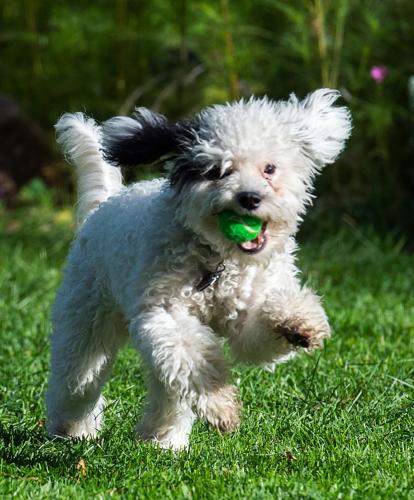Who spends more time in your yard than you do? Likely your dog.
Here are a few tips to make your outdoor spaces more canine-friendly.
If you were the dog, what would you want? Room to run? A place to dig? A nice, shady respite? Perhaps all of the above.
“Soft foliage, sturdy turfgrass, smooth stones and dog toys can help your pet feel at home. Add a water station so your pet can hydrate after some time playing,” advises Kris Kiser, CEO & president of the Outdoor Power Equipment Institute and Turfmutt, based in Alexandria, Va.
Choose sturdy, nontoxic garden plants. Dogs don’t naturally avoid toxic plants and might eat them. The American Society for the Prevention of Cruelty to Animals has a list of plants that can be poisonous to dogs: goo.gl/ythsYt. You also can search for plants that are harmful to cats or horses.
The site lists “plants that have been reported as having systemic effects on animals and/or intense effects on the gastrointestinal tract,” says the ASPCA, but note that “the consumption of any plant material may cause vomiting and gastrointestinal upset for dogs and cats.”
Included are some common plants used in the Pikes Peak region, such as the Begonia, chamomile, daffodil, dahlia, daisy, geranium, gladiola, hosta, iris, peony, tulip and yucca.
If you think your dog might have eaten a poisonous plant, contact your veterinarian or call the Animal Poison Control Center’s 24-hour emergency poison hotline at 1-888-426-4435.
Pick paw-friendly materials. “Plants with soft, sturdy foliage such as ornamental grasses can stand up to dogs without injuring them,” Sunset magazine reports. Splinter-free bark mulch, round river pebbles and flagstone are easy on the paws.
You can plant (safe) vegetation such as ornamental grasses as doggy boundaries. Place plants close together to designate areas, such as flowerbeds, as off-limits, and train your pet to avoid them. Leave some open areas for your dog to run and play in.
If you use metal or other edging, choose one that’s paw friendly, advises the Associated Landscape Contractors of Colorado. Poured concrete edging, brick pavers and concrete blocks are safe edging choices.
Think outside (or inside) the box. In your dog-friendly oasis, consider adding a splash pool just for your dog; a sandbox, digging box or bed if Fido loves to dig; and a “puppy pergola” for shade.
A child’s plastic pool probably isn’t sturdy enough for Fido. Chewy.com offers a collapsible version made of “extra-tough” PVC by Cool Pup for less than $75.
If you create a designated digging or play box, “add chew toys in the dirt (leave one poking out) to help your dog get the idea,” advises TurfMutt. You can even go all out and add a canine obstacle course, if you have the space.
Eliminate hazards. Paved surfaces can get too hot for your pet’s paws, so make sure your dog’s main play area has grass and shade. For practiced escape artists, check fences for holes and weak areas. Pay special attention to gates and locks to see that they are fastening properly. If your dog has tunneled under the fence, “you may need to install an underground barrier made of rebar, chicken wire, or poured concrete,” says Sunset magazine. If you use an invisible fence, test it to make sure it’s working properly and your pet knows the boundaries.
Make a window to the world. You can buy and install a fence bubble window or create a dog window in your existing fence using screening or glass. “It can help stop excessive barking since the dog will be able to see what they smell or hear just outside the fence,” says the DIY Network, which offers instructions on how to install a peek-through fence window: goo.gl/i1D4Hd. You can also find some creative alternatives with a Pinterest search.
Provide access to water. According to Dogster.com, an average, healthy dog drinks about a half to 1 ounce of water per pound of body weight each day. Puppies need a half-cup of water every two hours. A water element such as a pond or waterfall can do the trick. Or just make sure there’s a water bowl that’s always filled.
Designate shady spots and shelter. Summertime sunshine is abundant in the Pikes Peak region, as are hailstorms. Make sure there’s a nice, shady spot under a tree or bush. Or install a doggy door into a garage so Fido can escape the weather. A good old-fashioned doghouse works, too.
Enjoy. A backyard that’s dog-friendly should make its humans happy, too.










 Your Privacy Choices
Your Privacy Choices